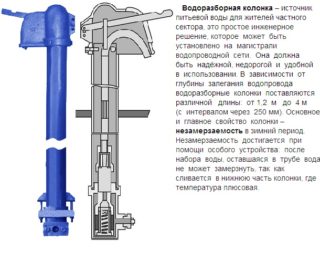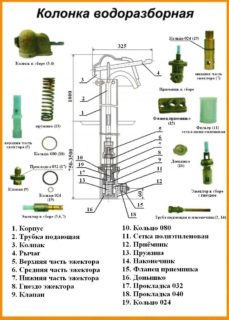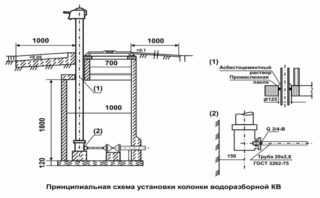Until recently, street water intake columns were an integral part of the structure of small towns and villages. Their main purpose is to supply water, which was used for domestic needs. They installed these devices on the streets on water supply networks. For the installation of the device, a well was necessarily formed, in which the main part of the device was located.
Requirements for the water column
- At the location of the water well, the column is installed. If there is no well, it is recommended to build it as close to the sidewalk as possible. The ideal location is a crossroads.
- The coverage of consumers is carried out on the basis of one column per area with a radius of 1000 m.
- It is optimal if the street water intake is formed on sandy soils for easy drainage of water into the ground.
- An elevated installation location is better than a low one.
- In winter, it is better to insulate the column, because the metal case cannot protect the water from freezing.
- Installation is carried out on water supply networks in which the pressure does not drop below 1 atm.
All the fulfilled requirements guarantee long-term and efficient operation of the device. In this case, the depth of the laying of water pipes must be taken into account. Based on this parameter, the model of the device is selected.
Specifications
The water dispensers produced in Russia are strictly produced in accordance with GOST. Therefore, they have standard specifications:
- operate at a water pressure inside the water supply network of 0.1-0.6 MPa;
- the diameter of the pipe connecting the device to the water supply system is 20 mm;
- outlet pipe diameter - 15 or 20 mm;
- vertical valve stroke - 16-18 mm;
- the mass of the device with a length of 1.25 m is 31 kg, the weight increase is 2.6 kg for every 25 cm of increase in the length of the device.
The column casing is made of steel or cast iron, painted so that it does not rust. The device itself is a collapsible device, so it can be easily repaired. Manufacturers offer any parts and assemblies as spare parts.
Device and principle of operation
- a standpipe located inside the body;
- ejector, consisting of three parts: throat, socket and receiver (sump);
- at the bottom of the device (receiver) there is a cylindrical mesh, the task of which is to filter the water entering the column;
- the column case is covered with a metal cover in which the lever is installed.
The column works as follows:
- when pressing the lever, the downpipe is lowered;
- at the end of the latter, a neck is installed, which is a cylindrical object with a chamfer at the end;
- the latter, when the lever is pressed, rests against the socket so that the riser does not fall;
- at the end of the riser there is a valve located at the bottom of the column - a sump (receiver);
- the valve closes or opens the opening of the receiver;
- when you press the lever, it goes down, opening the hole, that is, water moves;
- the lower end of the riser rests on the spring, which is located at the lowest point of the sump, it provides a reverse stroke of the entire structure;
- when the lever is released, the compressed spring expands, raises the riser, the valve closes the hole in the upper part of the sump.
The design of the column is very simple, so it works effectively for many years. Most often, the spring fails, which is always in the water. They began to make it from tool steel, which is not afraid of contact with moisture.
Sometimes the riser gets clogged. It is changed to a new one or cleaned by first disassembling the column.
The uniqueness of the design of the water column is that no water remains inside the riser. With the help of an ejector, it enters the housing through the hole in the coupling. Therefore, outdoor devices can be operated at temperatures from -40C to + 40C. This must be indicated in the product passport.
If the riser is frozen in winter, the reason is a drop in water pressure in the water supply system or a temperature indicator below the permissible value.
Types of water columns
Manufacturers offer two types of performance, which are marked as KB and KVO. In terms of technical characteristics, both devices do not differ from each other. The main difference is the way the receiver is attached to the device body.
In KV models, fastening is made with two bolts that pass through the ears. One is located on the speaker case, the second on the receiver. Gaskets are installed between the two units to ensure the tightness of the structure.
In KVO models, the fastening is carried out using square-shaped flanges. One of them is welded to the body, the other to the receiver. This design uses four bolts.
Installation features
A valve must be installed between the column and the supply pipe. The connection is made using flanges or threads. The first option is easier in terms of installation and maintenance. The purpose of the valve is to shut off the water supply and regulate its pressure.
A solid foundation must be laid under the column inside the well, on which it will rest. For this, a concrete pad is poured or a ready-made reinforced concrete slab is laid.
Before commissioning, the water column is washed with an aqueous solution of bleach. In this way, the device is disinfected. The well is closed with a cast-iron sewer hatch.
Operation and maintenance
The columns must be serviced monthly. Check for tightness of the ejector:
- a plug made of wood is plugged into the drain pipe located at the top of the riser;
- push the lever;
- water fills the entire volume of the column case;
- the lever is released, and if the water has not increased in volume within 10-20 minutes, it means that the ejector is tightly attached to the hole in the receiver;
- you need to remove the plug, press the lever again and empty the column housing completely.
If the ejector works correctly, in a 175 cm long water column, water will be removed from the body in 5-6 minutes.
If it is necessary to carry out repair work, first of all it is necessary to close the valve by disconnecting the device itself from the water. Next, the cap with the lever is removed, then the riser, after which you can inspect and repair the parts of the ejector and sump. Often the mesh is clogged, which just needs to be replaced with a new one.
Column cost
Prices for outdoor water taps for irrigation and other household needs are almost the same for all manufacturers. They depend on the type of execution and the length of the device.
- KV with a length of 275 cm costs 5,000 rubles;
- KVO 275 cm - 4500 rubles;
- KB 375 cm - 6300 rubles;
- KVO 375 cm - 5700 rubles.
Parts are sold separately: spring 240 rubles, mesh 170 rubles, valve - 150 rubles, - ejector 515 rubles, receiver assembly - 3500 rubles, receiver not assembled - 1500 rubles, cap - 1800 rubles.
It is not difficult to install and repair the water column. This should be done by representatives of the water supply organization.












Where can you buy such a water column for summer cottages in a plastic case or in a stainless steel case?